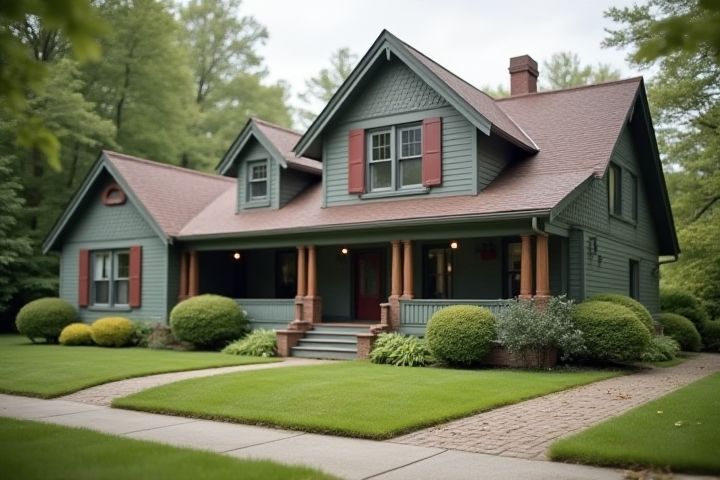
House zoning laws are regulations governing land use and development within specific areas or districts, ensuring organized community growth and land use compatibility. These laws dictate the types of structures that can be built (residential, commercial, industrial) and their intended purposes. Zoning can affect lot sizes, building heights, and the distance buildings must maintain from property lines, which are essential for maintaining neighborhood aesthetics and safety. You may encounter zoning classifications like single-family residential, multi-family residential, or mixed-use, each with specific rules about what activities are permitted. Familiarity with local zoning laws is crucial for homeowners and developers to avoid legal issues and navigate real estate opportunities effectively.
What Are House Zoning Laws
Land Use Classifications
House zoning laws regulate land use classifications to ensure organized development within communities. These classifications categorize areas for residential, commercial, industrial, and agricultural purposes, affecting property rights and development potentials. Understanding land use classifications is crucial for homeowners and prospective buyers, as these laws dictate what activities can occur on your property. Engaging with local zoning boards can provide clarity on permitted uses, ensuring compliance and maximizing your property's value.
Residential Zoning
Residential zoning laws regulate land use and define how properties can be developed or modified within a community. These ordinances categorize zones, such as single-family homes, multi-family units, and mixed-use developments, establishing density limits, building heights, and setback requirements. Typically, residential zones may stipulate a minimum lot size, which can range from 5,000 to 10,000 square feet, to maintain neighborhood character and ensure proper spacing between structures. Understanding these laws is essential for homeowners, as they impact property value, potential renovations, and investment opportunities in your local market.
Commercial Zoning
Commercial zoning laws regulate land use for business activities and ensure that commercial operations do not negatively impact surrounding properties. Areas designated as commercial zones are typically planned to accommodate different types of businesses, such as retail shops, office buildings, and restaurants, and may vary in intensity from neighborhood commercial to large-scale commercial hubs. Most municipalities have specific regulations governing building height, floor area ratio (FAR), signage, and parking requirements within these zones. Understanding your local commercial zoning laws can greatly influence your business location decisions and operational logistics.
Industrial Zoning
Industrial zoning laws regulate land use for manufacturing, warehousing, and distribution purposes, aiming to minimize conflicts with residential and commercial areas. These regulations dictate aspects such as the types of businesses allowed, building height restrictions, noise levels, and environmental impact considerations. You may find that these laws also require businesses to conform to safety and health standards, ensuring the well-being of surrounding communities. Understanding these laws is crucial for developers and investors, as they can significantly influence property values and potential returns on investment in the industrial sector.
Mixed-Use Zoning
Mixed-use zoning laws permit the integration of various land uses, such as residential, commercial, and recreational spaces, within a single development or neighborhood. These regulations aim to create vibrant communities by fostering walkability, reducing reliance on automobiles, and promoting economic growth through diverse business opportunities. When considering a property, your ability to develop or modify a site may be influenced by local mixed-use zoning codes, which dictate the types of activities allowed and their density. Understanding these laws can enhance your investment strategy and help you align developments with community needs and preferences.
Zoning Variances
House zoning laws regulate land use and determine how properties can be developed or modified within specific areas. Zoning variances are exceptions to these laws, allowing property owners to deviate from set regulations due to unique circumstances affecting their land, such as size, shape, or topography. Obtaining a zoning variance typically requires demonstrating that adherence to existing zoning restrictions would cause undue hardship or practical difficulties. You may need to present your case to a local zoning board, highlighting how the proposed changes would not negatively impact surrounding properties or violate the community's zoning intentions.
Building Height Restrictions
House zoning laws often specify building height restrictions to maintain community aesthetics, safety, and optimize land use. Typically, these regulations define the maximum allowable height for structures within a particular zone, often measured in feet or stories. For instance, residential areas may limit buildings to two or three stories, while commercial zones might allow taller constructions to accommodate businesses. Understanding your local zoning ordinances can help ensure that your plans align with these established height parameters, thereby avoiding potential legal issues or fines.
Setback Requirements
Setback requirements in house zoning laws dictate the minimum distance that structures must be set back from property lines, streets, or other designated features. These regulations ensure adequate space for safety, privacy, and access while promoting orderly development in residential areas. For homeowners, understanding these requirements is crucial to ensure compliance when planning construction, renovations, or expansions of their properties. Local zoning ordinances typically specify the exact setback distances, which can vary based on factors such as lot size, building height, and neighborhood zoning classifications.
Lot Size Minimums
House zoning laws often specify lot size minimums to control population density and ensure adequate space for residential development. These regulations typically vary between residential, commercial, and agricultural zones, reflecting the intended use of the land and promoting sustainable community planning. Minimum lot sizes can influence property values, as larger lots may appeal to buyers seeking privacy and space. Understanding these zoning requirements is crucial for homeowners and investors, as they directly impact land use and future development potential.
Rezoning Process
House zoning laws regulate land use to ensure orderly development within a community, and the rezoning process is crucial for adapting to changing needs. Typically, this process involves submitting a rezoning application, which may require community meetings and public hearings to assess local impact. Potential timelines for this process can range from a few months to over a year, depending on the jurisdiction and complexity of the request. Understanding your local zoning regulations is essential, as they dictate permissible land uses, density limits, and the overall character of your neighborhood.
